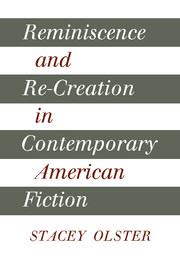Book contents
- Frontmatter
- Contents
- Preface
- Key to Abbreviations
- Reminiscence and Re-Creation in Contemporary American Fiction
- Introduction
- 1 A Disruption of Sensibility
- 2 The Transition to Post-Modernism: Norman Mailer and a New Frontier in Fiction
- 3 Thomas Pynchon: An Interface of History and Science
- 4 John Barth: Clio as Kin to Calliope
- Conclusion: “Subjective Historicism”
- Notes
- Bibliography
- Index
- PERMISSIONS
2 - The Transition to Post-Modernism: Norman Mailer and a New Frontier in Fiction
Published online by Cambridge University Press: 19 March 2010
- Frontmatter
- Contents
- Preface
- Key to Abbreviations
- Reminiscence and Re-Creation in Contemporary American Fiction
- Introduction
- 1 A Disruption of Sensibility
- 2 The Transition to Post-Modernism: Norman Mailer and a New Frontier in Fiction
- 3 Thomas Pynchon: An Interface of History and Science
- 4 John Barth: Clio as Kin to Calliope
- Conclusion: “Subjective Historicism”
- Notes
- Bibliography
- Index
- PERMISSIONS
Summary
“Soft-hearted philanthropists, ” thought I, “may sigh long for their peaceful millennium; for, from minnows to men, life is incessant war.”
–Francis Parkman, The Oregon Trail (1849)Already Alaska beckons on the north, and pointing to her wealth of natural resources asks the nation on what new terms the new age will deal with her. Across the Pacific looms Asia, no longer a remote vision and a symbol of the unchanging, but borne as by mirage close to our shores and raising grave questions of the common destiny of the people of the ocean. The dreams of Benton and of Seward of a regenerated Orient, when the long march of westward civilization should complete its circle, seem almost to be in process of realization. The age of the Pacific Ocean begins, mysterious and unfathomable in its meaning for our own future.
–Frederick Jackson Turner, “The West and American Ideals” (1914)Norman Mailer is not the first American writer to conceive of history in terms of war. Nor was he the only one to do so during the period of the 1940s and 1950s specifically. Whether set in World War I, like Faulkner's A Fable, or World War II, like Heller's Catch-22, whether depicting men overseas, like Mailer's own The Naked and the Dead, or men at home, like Bellow's Dangling Man, novels dealing with war often concerned themselves less with a particular war fought and more with War as a permanent process, a “fact or condition of nature, of physical laws, ” only punctuated by periods of armed combat (Fable 125). Mailer, however, has gone on to portray War without any one war ensuing.
- Type
- Chapter
- Information
- Publisher: Cambridge University PressPrint publication year: 1989



